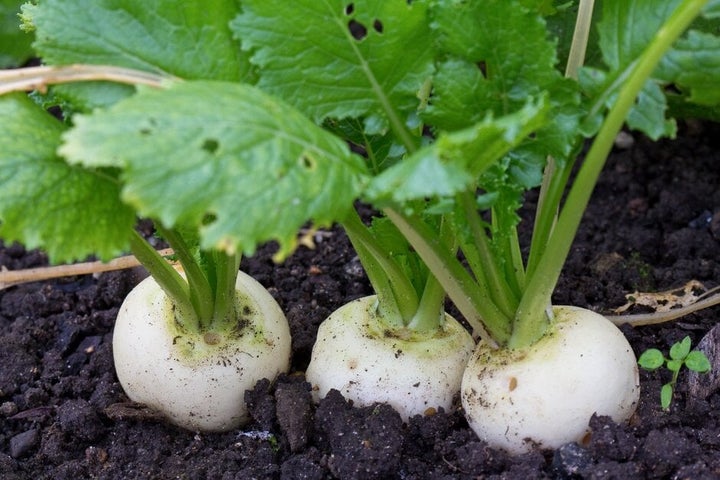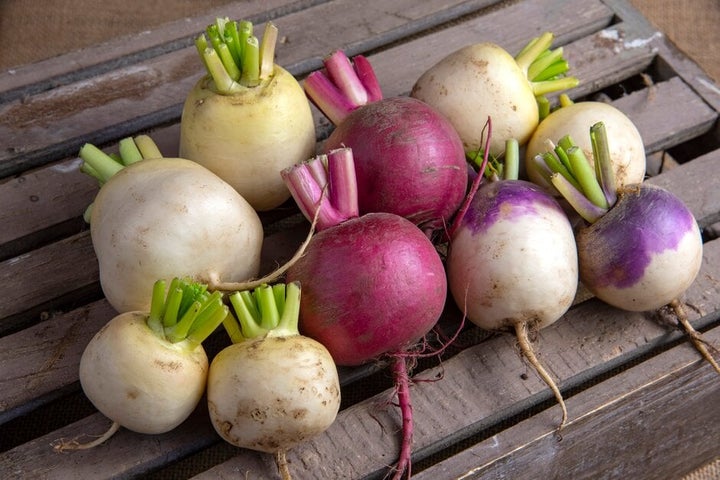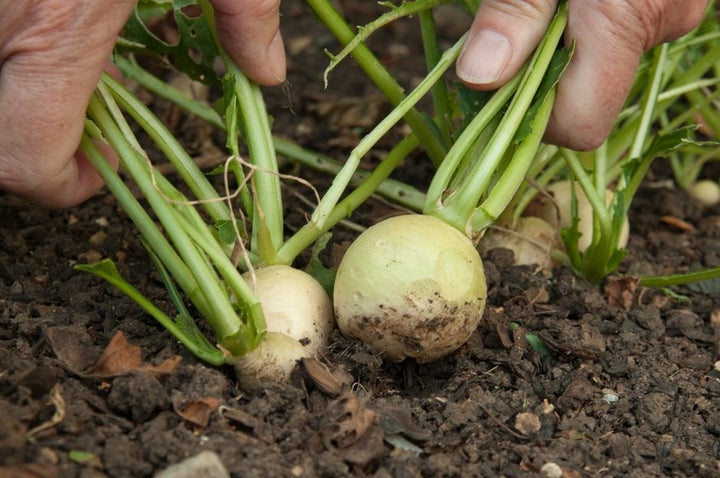Getting Started
This compact and fast-growing root vegetable is best sown little and often for harvesting from late spring until early winter. The young roots are delicious raw, roasted or added to stews, and the young leaves are edible too.

Turnips belong to the brassica (cabbage) family. They are easy to grow from seed, forming small rounded or flattened roots, usually with white or purple skins. They are ready in as little as six weeks and are best harvested young. The leaves can be eaten like spinach, making this a doubly useful crop. In some parts of the UK, swedes, with larger orange and purple roots, are known as turnips.
Turnips like a sunny spot and grow best in cool conditions, in fertile, moisture-retentive soil. You can also grow them in large containers, for harvesting as mini-veg. Sow seeds in small batches every few weeks from spring to late summer for regular harvests without any gluts.
Jobs to do now
Harvest
Month by Month
Sow
Plant Out
Harvest
Choosing What To Grow
Turnip varieties can be divided into two main types, according to sowing and harvesting times:
- Early turnips – sow March to June, for harvesting throughout summer. Some early varieties, such as ‘Atlantic’ and ‘Purple Top Milan’, can also be sown under cloches in February
- Maincrops – sow July to mid-August, for harvesting in autumn
Turnip roots vary in size, shape and colour. Most varieties produce rounded or flat-topped roots, either entirely white or yellow, or white with purple or green tops. With many varieties the leaves are tasty too, making a useful additional harvest. Varieties with an RHS Award of Garden Merit (AGM) always make a good choice, as they performed well in our trials – see our list of AGM fruit and veg (135kB pdf) and our Recommended Varieties below. For more veg-growing inspiration, visit the RHS gardens, which all grow a wide range of vegetables, including turnips and other root crops.

What and where to buy
Turnips seeds are widely available in garden centres and from online suppliers.
Recommended Varieties

‘Atlantic' AGM
An early purple-topped variety, good for harvesting as baby veg, especially when grown in containers.

'Temari Red' AGM
Small, rounded, scarlet red roots. The inner flesh is white with a red blush.

‘Tokyo Cross’ AGM
One of the oldest varieties and one of the best. Fast-growing, white, semi-globe roots are crisp and mild.
Preparing The Ground
Turnips grow best in a sunny spot and like rich, well-drained soil, so dig in plenty of organic matter, such as garden compost or well-rotted manure, ideally the autumn before sowing.
Weed the area and rake the soil to a fine crumbly texture. Alternatively, if you're practicing no-dig, the soil with organic matter ahead of sowing or planting directly into the mulch.
Sowing
The main sowing season is from March to mid-August, although you can sow in February under cloches or in a greenhouse. Choose early varieties for sowing up to June, and check seed packets for recommended latest sowing times. Turnips prefer cool conditions, so spring sowings usually germinate quickly and well, but in hot, dry weather may be less successful.
Like most root crops, they’re best sown direct outdoors, where they are to grow, either in the ground or in a large container. But they can also be sown indoors in in late winter, for planting out before their roots start to develop, for an early harvest.
As they grow so rapidly, turnips are great for filling gaps after harvesting other crops, or for sowing between slower-growing crops, such as parsnips, for harvesting before the slower crop needs the space. If you make regular small sowings, you avoid large gluts and can have harvests from late spring to autumn and beyond.
Sowing indoors
For earlier harvests, you can start hardy turnip varieties indoors in late winter. Fill a modular tray with peat-free , then sow seeds 2cm (1in) deep – either two seeds per module then remove the smaller one if both germinate, or up to four seeds per module, to keep as a small clump, for harvesting as mini-veg. For more sowing tips, see our guides below.
Sowing outdoors
In prepared ground make a shallow , 1cm (½in) deep, and water along the base if dry. Scatter the seeds thinly along the drill, then cover with soil, firm gently and water lightly. Space any additional rows 23–30cm (9–12in) apart. For more sowing tips, see our guides below.
out may not be necessary for baby veg or when growing for the leafy tops, although 10cm (4in) apart is ideal. For larger roots, thin the seedlings to 15cm (6in) apart for early varieties, and 23cm (9in) apart for maincrops. You can use the leafy thinnings in salads.
Sowing in containers
If you’re short on ground space, or just want a few small or mini-roots, you can sow turnips in a large pot in a warm, sunny location. Choose a container that’s at least 40cm (16in) wide and fill with peat-free multi-purpose , then water well. Scatter the seeds thinly, cover with 2cm (1in) of compost and firm gently. Once the seeds germinate, thin out to 10cm (4in) apart for harvesting as mini-veg.
Transplanting
Young plants from early indoor sowings will be ready for planting outside from March onwards. Prepare them for outdoor conditions by hardening off, so they don’t suffer a check in growth. Then plant out with minimal root disturbance, spacing them 15–23cm (6–9in) apart. If sown as a clump, don’t split up the .
Water in and protect the seedlings from slugs and snails, especially in damp weather. If birds are a problem, cover with netting or .
Plant Care

Watering
Water turnips in dry weather, otherwise the roots will be small and woody, and may split. Dry conditions can also cause plants to bolt (flower prematurely), which stops the root swelling. Plants in containers need regular watering, as the dries out quickly, especially in summer. For water-saving tips, see our guides below.
Weeding
Keep turnips weed free, especially when young, so they don’t have to compete for light, water and nutrients. Weed by hand close to the plants, to avoid accidentally damaging the root tops with a hoe blade.
Harvesting

Turnip roots grow rapidly – early varieties can be ready to harvest in only six weeks and maincrops in about ten weeks, depending on the growing conditions. They are best harvested when small and full of flavour. If left to grow larger than a tennis ball, they can turn woody and bitter.
The roots are not completely hardy, so it’s safest to harvest late-sown turnips before the weather turns really harsh and frosty. In mild regions, you can leave them in the ground, protected with cloches or plastic-free fleece, and lift roots as needed through winter. Autumn-harvested roots can also be stored for several weeks in trays of moist coir or sand, in a cool, frost-free place – see our guide to storing root veg.
The leaves, or turnip tops, can be harvested too – either at the same time as the roots, or when small and tender, as a cut-and-come-again crop, providing several pickings. Young leaves have a peppery flavour and can be eaten raw, while larger leaves up to 15cm (6in) can be cooked like spinach. If you’re growing mainly for the roots, don’t harvest too many leaves from each plant, otherwise root growth may be reduced. But you can also grow turnips entirely for their leafy greens, making repeated harvests.
The main harvesting seasons are as follows:
- Early turnips: harvest from May to September when the size of a golf ball for eating raw, or the size of a tennis ball for cooking
- Maincrops: harvest from October onwards
- Turnip tops: harvest the leaves from spring onwards. Leaves will re-sprout, so you can make several pickings
Problem Solving
Once established, turnips are generally healthy and robust plants, although usually need protection from slugs. Still, as members of the cabbage family, they can be affected by the same insects and diseases as cabbages, including cabbage root fly and club root. Birds sometimes eat the leaves, in which case you can cover the crop with netting. For more on how to tackle these issues, see Common problems below.
Common Problems

Cabbage caterpillars
Cabbages and other brassicas are a food source for the caterpillars of several species of moth and butterfly.

Cabbage root fly
The maggots of cabbage root fly eat the roots of cabbages and other brassicas, they can also tunnel into the roots of swedes, turnips and radish.










